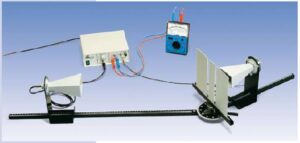O.2(1) – Projection of Grating Spectra
Interference patterns produced by a diffraction grating are projected on a screen. The transmission-type diffraction grating flints on a stand just in front of a HeNe laser, and is brightly projected on the lecture room screen. This demonstration slide has three 9 mm x 16 mm gratings with 100, 300, and 600 lines per mm. They are mounted between glass plates in a 3 cm x 9 cm slide card. One can also shine the laser beam on a compact disk as an example of reflection-type diffraction grating.
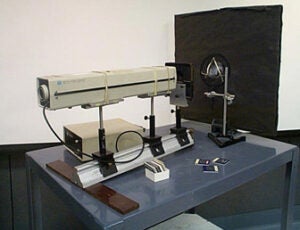
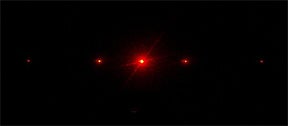
O.2(2) – Different Gases Spectrum
Spectral lines of 5 different gases and for white light are identified by the students with the help of individual transmission-type grating glasses. There are discharge tubes of: He, Xe, Ne, Ar and Hg. Each tube is about 30 cm long.
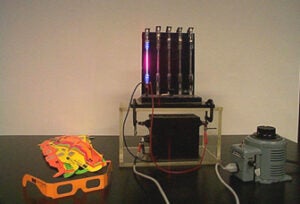
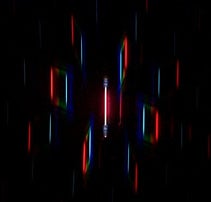 |
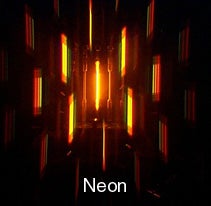 |
 |
 |

O.2(3) – Newton’s Ring Apparatus
This apparatus consists of a flat plate and a convex lens of long focus, both 8.5 cm in diameter, mounted in brass frames fitted with three knurled compression screws. The circular interference fringes can be projected on a screen using a HeNe laser beam. The projection can be made large enough to be seen by the whole class. An interference pattern can be viewed off screen using other light sources.
One can also show that this interference pattern appears when a simple glass plate and a watch glass are set together and slightly pressed against each other. The same pattern appears but it is not as stable since as you move the contact point the pattern moves and distorts. A HeNe laser beam is also used as a light source.

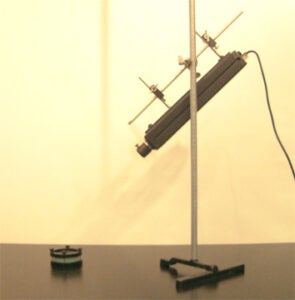
O.2(4) – Interference Model
This demonstration model gives a large graphic display of how interference occurs. Wave fronts are represented by concentric circles drawn on transparent plastic plates that fit in the overhead projector. As the centers of the two plates are moved relative to one another, the interference patterns appear.

O.2(5) – Single and Double Slit Diffraction
A HeNe laser is used as the light source in the projection of diffraction patterns due to single slit and double slit slides. The single slit slide has four different widths, and the double slit has four different spacing. With the double slit slide on, the single slit diffraction pattern can be recovered by using an opaque edge to carefully block one of the slits.
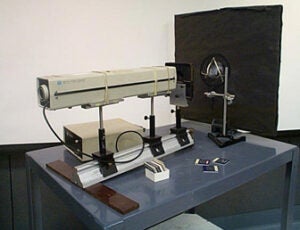

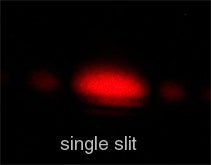
O.2(6) – Other Diffraction Patterns
Slides with pinholes, gratings, different widths wires, and straight edges, circular and square apertures are available. One can also show the complementary diffraction patterns of a pinhole and an opaque disk. The diffraction pattern of an opaque disk demonstrates the Poison’s spot. The diffraction patterns are projected on a screen using a HeNe laser as light source (the same set-up used in the previous demonstration).
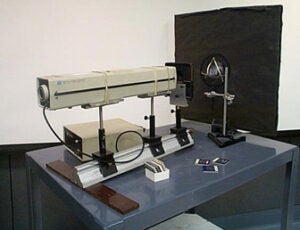
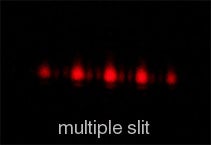

O.2(7) – Diffraction Grating Model
This model demonstrates the principles of constructive and destructive interference as produced by the diffraction grating. The grating corresponds to a spacing of 6000 lines/cm illuminated by sodium light at wavelength 5892 Angstroms.
Dimensions: width: 56 cm, height: 40.5 cm.
O.2(8) – Young’s Double Slit Apparatus
This model graphically demonstrates the wave phenomena of double slit interference. Model has a variable slit width of 4.5 micron and 2.25 micron. A phase adjuster allows the incident wave front of one slit to be thrown out of phase with respect to the other slit to illustrate the interference pattern.
Dimensions: width: 40 cm height: 65 cm.
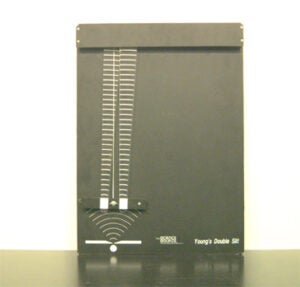
O.2 (9) Microwave Optics
In this experiment a microwave transmitter and receiver are used to study the properties of electromagnetic waves. Both receiver and transmitter are connected to a control box, which allows for transmitter signal amplification and for receiving signal options. The receiver signal can be observed through a voltmeter or as an auditory signal. The auditory signal is recommended for large classrooms where voltmeter observance may not be possible. The demonstration contains multiple setups that display straight-line wave propagation, penetration of a fiberboard screen, screening and absorption, reflection, refraction through a paraffin prism, diffraction, interference, and polarization. A variety of metal screen sizes are also included to give versatility in diffraction and interference pattern.
